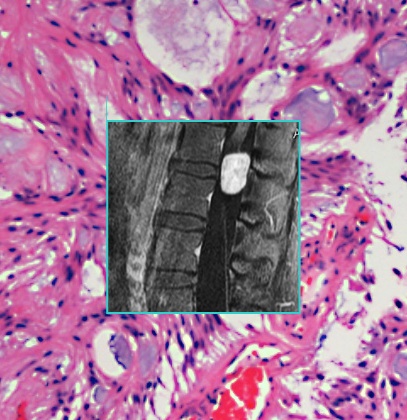
Spinal Cord Tumors
What are Spinal Cord Tumors?
Spinal cord tumors are abnormal growths that develop within or near the spinal cord. These tumors can be classified into two main categories: intramedullary tumors and extramedullary tumors. Spinal Cord Tumors comprise a number of benign and malignant tumors that can originate in or around the spinal cord.
The exact causes of spinal cord tumors are not fully understood. Some tumors may be associated with genetic conditions, such as neurofibromatosis or von Hippel-Lindau disease, while others may occur sporadically without a clear underlying cause. Exposure to radiation, certain chemicals, or certain genetic mutations may also contribute to the development of these tumors in some cases.
Types of Spinal Cord Tumors
Intramedullary Tumors
Intramedullary tumors originate from cells within the spinal cord itself. The most common type of intramedullary tumor is an ependymoma, which arises from the ependymal cells lining the central canal of the spinal cord. Other types of intramedullary tumors include astrocytomas, gliomas, and hemangioblastomas. These tumors tend to grow slowly and may cause compression of the spinal cord, leading to symptoms such as progressive weakness, sensory changes, loss of coordination, and impaired bowel or bladder function.
Extramedullary Tumors
Extramedullary tumors, on the other hand, develop outside the spinal cord but within the spinal column. They can arise from different structures, such as the nerve roots, meninges, or surrounding tissues. Common types of extramedullary tumors include meningiomas, schwannomas, and neurofibromas. These tumors often cause symptoms by compressing the spinal cord or nerve roots, resulting in pain, weakness, sensory deficits, and changes in bowel or bladder function.
Treatment for Spinal Cord Tumors
Spinal cord tumor surgery aims to preserve or restore neurological function
Most symptomatic spinal cord tumors require surgical removal which can typically be performed with small incisions on the back or neck and little bony disruption. Depending on the type of tumor, further treatment may be indicated, including radiation or chemotherapy.
Occasionally, spinal stabilization is necessary, which is performed in conjunction with our spine surgery colleagues. By incorporating cutting edge technology and instrumentation with proven surgical experience, we make surgery safer, less invasive and more effective. Learn more about spinal cord tumors.
Overview
Spinal cord tumors arise in the spinal cord itself or adjacent to the spinal cord and can occur in the cervical, thoracic or lumbar regions. Those that occur within the spinal cord are termed intradural intramedullary spinal cord tumors and include several subtypes: astrocytomas, ependymomas, hemangioblastomas and metastatic cancers (from another cancer type).
Those that occur alongside the spinal cord are called intradural extramedullary spinal cord tumors and include meningiomas, schwannomas, neurofibromas and myxopapillary ependymomas. Some spinal cord tumors occur as part of an inherited genetic disorder which includes Neurofibromatosis type 2 (associated with spinal schwannomas, meningiomas, ependymomas and astrocytomas) and Von Hippel-Lindau syndrome (associated with spinal cord hemangioblastomas).
Symptoms
Given their location, tumors in or alongside the spinal cord typically cause symptoms in the arms and/or legs including gradually worsening muscle weakness which may lead to paralysis, sensory loss or abnormal sensations, bowel or bladder problems including urinary retention, incontinence and constipation, as well as back pain.
The general location of a spinal cord tumor can often be determined based on the specific pattern of weakness and sensory loss. Cervical spinal cord tumors can lead to weakness and sensory changes of both arms and legs whereas thoracic or lumbar spinal tumors do not affect arm function.
Diagnosis
Spinal cord tumors are best diagnosed by imaging studies, typically magnetic resonance imaging (MRI) of the cervical, thoracic or lumbar spinal regions with and without gadolinium; occasionally a CT myelogram is indicated.
Treatment
The optimal treatment for a spinal cord tumor is in-part related to the type and location. However, the great majority are treated with surgical removal usually through a laminectomy and microsurgical resection. The goal of surgery is maximal but safe removal with avoidance of worsening neurological function. Tumors within the spinal cord (intramedullary) including astrocytomas, ependymomas and hemangioblastomas of the cervical, thoracic and lumbar regions, are removed as completely as possible.
For astrocytomas, given their infiltrative/invasive nature, complete removal is often not possible and additional therapy with radiation or sometimes chemotherapy may be needed. Myxopapillary ependymomas of the cauda equine or filum terminale (lumbar) region, as well as spinal meningiomas and schwannomas that arise outside the spinal cord are often able to be removed in complete fashion, but adhesions to the spinal cord or nerve roots may preclude complete removal in many patients. For incompletely removed meningiomas, schwannomas or ependymomas, focused radiotherapy may be indicated.

Doctors and Specialists Who Treat Spinal Cord Tumors
Clinic Locations
Pacific Spine Health
5215 Torrance Blvd., Torrance, CA 90305
424-212-5361
2125 Arizona Ave., Santa Monica CA 90404
310-582-7450






